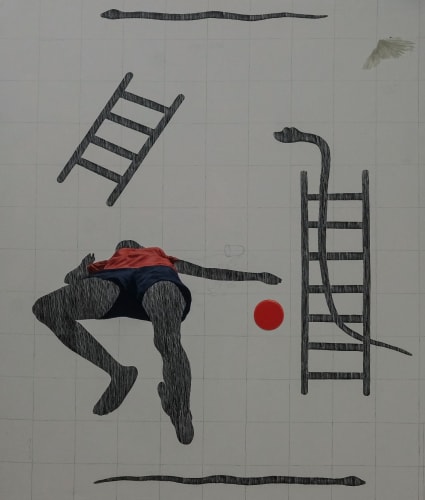Rele Gallery is pleased to present a solo exhibition in Lagos of new work by Ameh Egwuh titled It was meant to be a game. On view from October 22 till December 6, 2023, the exhibition offers new experiments in painting and drawing, marking a shift from Egwuh’s brightly coloured canvases while retaining a fundamental preoccupation with line and traditional mark-making.
Presenting multiple paintings on canvas and works on paper, the artist employs a mixture of lines and images drawn in graphite to create grayed-out, muted backgrounds in contrast to the painted central subjects. The works in this exhibition are inspired by and reference the classic Snakes and Ladders games, with subjects shown against checkerboard landscapes in which striped images of snakes and ladders float. Much like the origin of the game — which is rooted in Indian philosophy and was initially used as a tool for teaching moral lessons to children and adults — the exhibition takes as a central subject the individual and collective choices that inform our understanding of the moral and social qualities of life.
Despite its popularity in contemporary cultures as a simplified children’s game of luck and entertainment, in its original form, the ‘Snakes and Ladders’ game was designed to represent the concept of karma and the journey of life towards spiritual enlightenment. The ladders in the game were seen as symbols of positive virtues and good deeds, leading players closer to enlightenment. Conversely, the snakes represented vices and bad actions that could set players back on their spiritual path. In his paintings, Egwuh evokes a moment, interaction or state of being in examining tangible and abstract ideas that govern aspects of social engagement and an individual journey through life. An armed figure similar to law enforcement officials raises questions on the social construction and manifestation of power; an image of a baby leopard playing with a butterfly conveys the beginning stages of life; a diptych of two figures in different states of embrace insinuates the duality of the human experience, a constant, oscillatory movement between the good and bad.
Similar to the game, Egwuh’s canvases are filled with scenes that evoke moral binaries, although missing the recompense present in the game. Connotations of religion, power, lust, love, and greed amongst other moral positions can be read from one canvas to the next. In his presentation, the artist offers no personal judgment on the acts that unfold against the checkered backgrounds, leaving the debating of morality to the audience. He instead serves as an unbiased channel for the presentation of events, characters and intimacies of existence. In exploring possible meanings and ideas on existence, the artist presents duality and dichotomy; between free will and fate; virtues and vices; desire and destiny.
In his gray backgrounds and drawings in graphite, Egwuh invites the audience to closer inspection, to meticulously tease out the nature of objects devoid of color; is the spill at the foot of the armed man a puddle of water or a pool of blood? How do these different possibilities affect our reading and understanding of the larger composition? The artist refers to every single work as a moment, conveyed by an impartial narrator. In viewing these works, we begin to play a game of sorts, imagining what ends of the morality spectrum the moments on view belong to. Or do they exist beyond the simple duality of black and white, in the more marginal, ambiguous sphere of the gray?
About Ameh Egwuh
Ameh Egwuh (born 1996) is an artist whose paintings are characterized by a fascination with the line.
His lines draw inspiration from the scarification techniques of ancient Ife art — striated grooves etched onto faces — as well as Adinkra, and Nsibidi signs, which are indigenous pictograms and aphorisms. Employing these pre-colonial art traditions while referencing contemporary art history, his works invite the viewer into expansive, multi-layered worlds from the familiar to the surreal, presenting us with intimate casual scenes of play and rest as well as fantasy images of transcendence.
Exploring themes of home and familial responsibilities, solitude, identity and duality as well as death and the afterlife, Egwuh utilizes multiple modes of representation from expressionistic painting techniques to geometric patterns — drawn from textile designs from his hometown, Idoma in Benue state — in representing form and space. His eclectic visual vocabulary conveys varying textures of lives lived and spaces occupied.
Ameh Egwuh studied Fine and Applied Art at Delta State University, Abraka, Delta State. In 2019 he participated in the inaugural edition of Rele Arts Foundation’s Young Contemporaries Bootcamp and was selected in 2020 as part of Rele Arts Foundation Young Contemporaries.
Select group exhibitions include Being Mortal (2023) Dom Museum Wien, Vienna Austria, Travels with Herodotus: A Journey Through African Cultures, (2021), Galleria Bianconi, Milan, ItsAwRAP (2021), Rele Gallery, Lagos, Generation Y, (2018), Retro Africa, Abuja. In 2020, Egwuh’s work was shown at FNB Art Joburg and South South Veza. The first part of his debut solo show Life After Life opened at Rele Gallery, Los Angeles in April 2021 and the second, Fantasies of the Other Side opened in October 2021, Rele Gallery Lagos.
Egwuh lives and works in Lagos.


